The Motorola Moto G4 and G4 Plus Review
by Brandon Chester on August 15, 2016 8:00 AM EST- Posted in
- Smartphones
- Lenovo
- Motorola
- Moto G
- Moto G4
GPU Performance
As I mentioned on the last page, moving from Snapdragon 410 to Snapdragon 617 doesn't really lead to a significant improvement in real-world CPU performance. What does improve is GPU performance, which is something that has always been a bit of a problem on low-end and mid-range smartphones. The 2015 Moto G used Qualcomm's Snapdragon 410 SoC. Snapdragon 410 uses Qualcomm's Adreno 306 GPU, which put the 2015 Moto G in a bit of an odd position because that same SoC was used in the significantly cheaper Moto E. Snapdragon 617 uses Adreno 405, which we've demonstrated as providing significantly faster performance than Adreno 306 in past reviews of other devices that use it. It's worth testing a device to ensure everything is working correctly even if you already have results for another device with the same SoC, and so I've run our 2016 GPU benchmarks on the Moto G4.
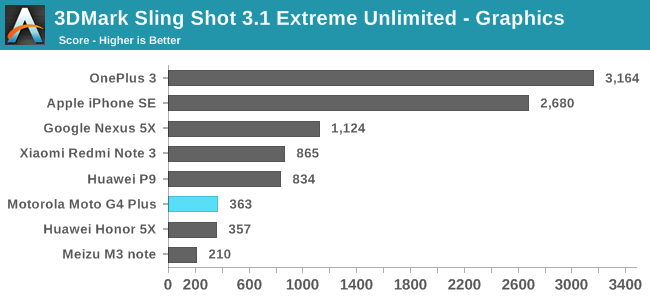
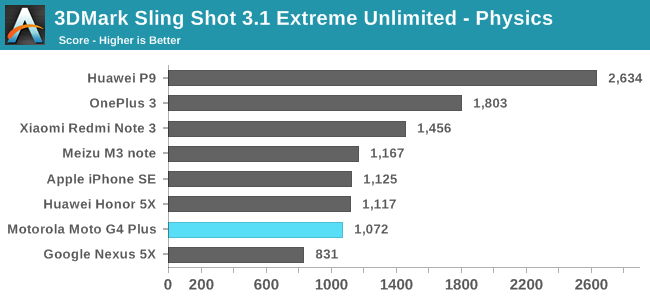
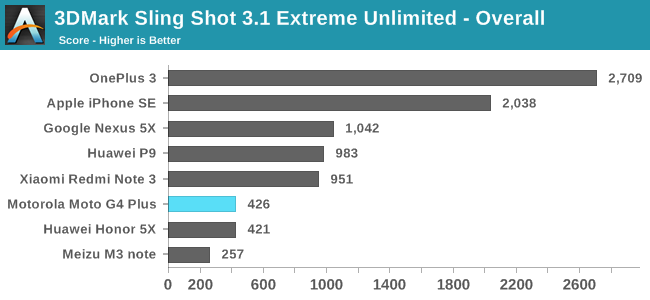
The 2015 Moto G doesn't support OpenGL ES 3.1, and so there's no way to run 3DMark Sling Shot Extreme Unlimited which uses ES 3.1 on Android and Metal on iOS. Snapdragon 617 uses the same Adreno 405 GPU as Snapdragon 615, and you can see in the results that the performance is right in line with the Huawei Honor 5X which uses Snapdragon 615. For a mid-range phone this is generally good performance, but once again the Xiaomi Redmi Note 3 sits far ahead of the rest of the mid-range smartphones, including the Moto G4.
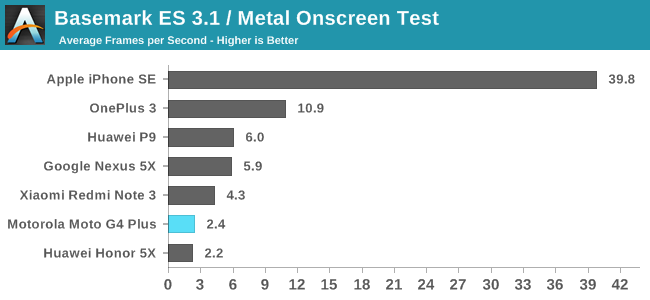
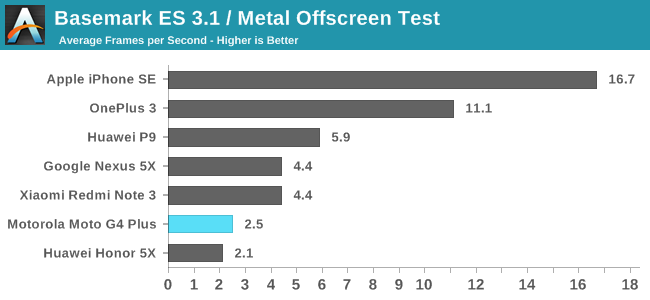
The situation in BaseMark ES 3.1 is the same as 3DMark, with the G4 Plus achieving roughly the same performance as the Huawei Honor 5X. The Xiaomi Redmi Note 3 with its Adreno 510 GPU ends up being a little over 75% faster, which is a huge improvement even if both devices technically don't get close to a playable frame rate in this very heavy test.
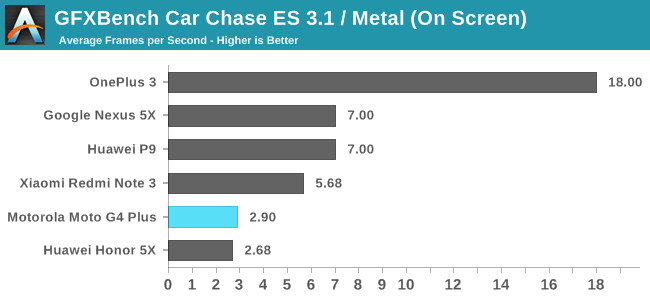
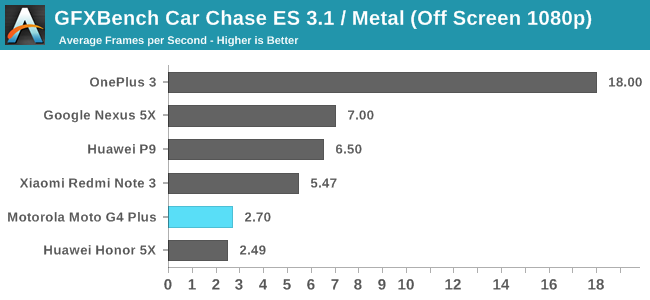
In GFXBench Car Chase it's the story is the same. The Moto G4 Plus is in line with other Adreno 405 devices, but the question is really whether or not that's good enough for a device launching this late into 2016.
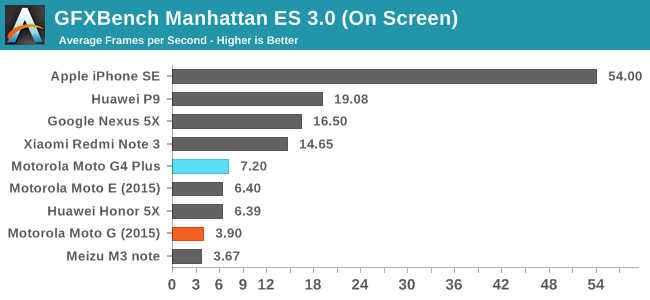
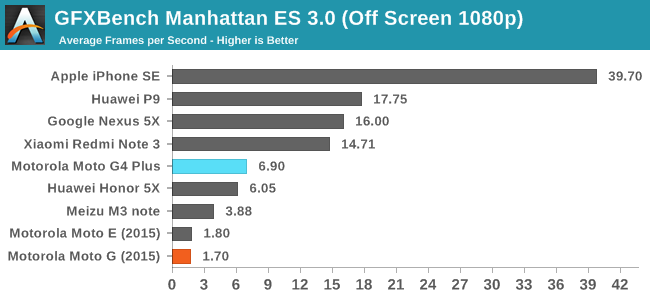
We've generally moved to Manhattan ES 3.1 / Metal for our reviews, but in cases like this where a device's predecessor doesn't support OpenGL ES 3.1 it's helpful to bring back Manhattan ES 3.0 to do a direct performance comparison. As expected, the Moto G4 is much faster than the 2015 Moto G, with on screen performance being about 85% faster despite the move from 720p to 1080p. and off screen performance being over four times faster.
It's clear that the Moto G4 provides much better GPU performance that the 2015 Moto G. However, much like the CPU benchmarks, I keep looking at the charts and seeing the Xiaomi Redmi Note 3 sitting well above the Moto G4. Adreno 405 is much better than Adreno 306, but Adreno 510 is two times faster than Adreno 405. I feel like the Moto G4 is simply launching too late for this kind of performance to be competitive, as it's tied with the Honor 5X which was launched at $200 nearly a year ago. While I don't mean to take away from the fact that the Moto G4 does provide faster GPU performance than its predecessor, I think there are devices right around the corner that are going to make a mid-range smartphone with Snapdragon 617 look decidedly last generation.
NAND Performance
NAND performance is still an area of concern on mid-range smartphones, but the situation has gotten better in recent times. The 2015 Moto E was an example of a device with very poor NAND performance, but the 2015 Moto G was significantly faster across the board. Motorola is still using eMMC memory, but there's definitely room for improvement over the 2015 Moto G even when sticking with an eMMC storage solution. To evaluate the Moto G4's storage performance I've run AndroBench 4.0 on both the 16GB Moto G4 and the 64GB Moto G4 Plus.
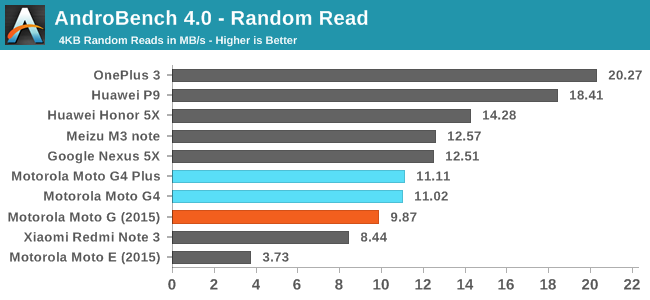
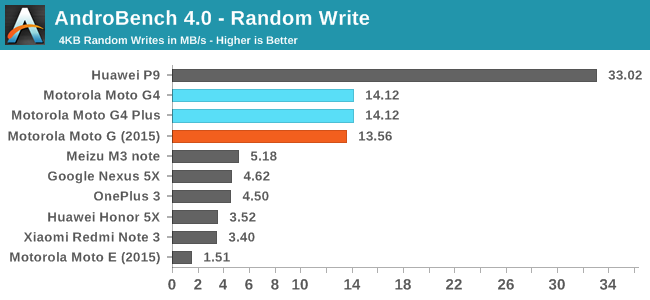
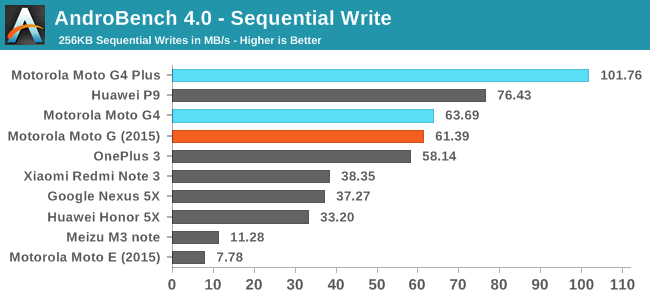

Among mid-range devices, the 64GB Moto G4 Plus performs very well. Random write results are ahead of all other devices on the chart except the Huawei P9, which isn't really a mid-range device and is just there for SoC comparisons. In the sequential write test the Moto G4 leads, which is due in part to the larger capacity allowing greater write parallelism. Sequential read performance is very good as well, although obviously not competitive with UFS 2.0 storage solutions like the one used in the OnePlus 3.










94 Comments
View All Comments
Belard - Tuesday, August 23, 2016 - link
I am disappointed with the G4, hopefully they'll correct a lot with the G5?My list:
1 - The loss of the Moto shape. The G4 looks generic, flat and "ugly" in my book. Compare to the other NON-USA Lenovo phones, I would have thought they could have done better. The curved back on the G3 and older MOTO phones gave it personality and felt good in the hand. You can tell which side is the TOP without feeling the camera hump/stripe.
2 – Its easier to pick up a phone with a curved back. Simulate it by placing your phone face-down and only picking it up by the edge.
3 – My Moto G3 is functional water proofing. Enough that I take underwater video with my phone. Was it really that hard to continue with such quality?
4 – The finger reader is completely ugly and ruins the whole phone. Should have put it on the back for the Moto Logo. That would have worked very well.
5 – 5.5”?! Can someone make a well made 5” model? The G4Play is no better than the G3… but loss its water proofing and has the plain ugly flat back.
6 – Stereo speakers. The G2 had them. The G3 has a large grill, but its not a speaker. On the G4, the mic-hole looks out of place where it is.
Come on Lenovo, fix the design for the G5 model. I’ve seen some of the Lenovo phones in Asia that are works of art. Such as the 3-layers metal phone, etc. Hell, even the new Z has some design flaws that should have been fixed.
jamesfuston - Tuesday, August 30, 2016 - link
One of the largest considerations for me in purchasing this phone was completely omitted from the summary of this article: support for every major US carrier. I get that this is a technical analysis and comparison of smartphones as computational devices, but the fact that you can use a G4/G4P on Verizon or Sprint (where a Huawei 5X will not function) is a MAJOR plus in the $200 smartphone category. Broad carrier support + fast charging, two features that provide day to day value and utility on a smartphone, make the G4 an easy pick for the best budget smartphone in my opinion.Allan_Hundeboll - Wednesday, September 7, 2016 - link
I don't own this phone but I think Brandon Chester judge this phone a little hard...Personally I used to prefer smaller phones to but once you go large you don't wont to go back. So if Brandon believe 5.5" inch is to big it's his personal preference.
I also do not agree the G4 Plus should have prioritized a faster SOC over fingerprint reader and camera. I know anandtech readers low fast hardware but for the average customer modern phones are fast enough, so better camera and the convenience offered by a fingerprint reader matters more than a slightly faster SOC.
Itbusiness.ca managed to complete PCMarks battery test with the G4 Plus and it scored a respectable 9 hours and 40 minutes.
mmartel - Tuesday, October 11, 2016 - link
I'm a long time user of a 2015 G3 who decided to buy and test out a US XT1625 G4 with 2/16 ram/storage for myself. I've also owned and gave away a Nexus 5X (loved the camera, hated the battery life). I've been using the G4 for the last 2 weeks and wanted to share a few thoughts.1. I don't doubt the official review but I think the model that was tested differs from the current firmware. I've found the 6.0.1 Android version on my device to very stable, responsive, and efficient.
2. The buttons on my device are very solid. Additionally I find the placement perfect for my hands and how I generally hold the device. YMMV obviously.
3. I don't love the size, but I am falling for the screen size. I worry about dropping the device and it's not as comfortable for me to use one handed. However that has everything to do with the size and nothing to do with the materials and shape.
5. The SoC performance really is good enough for all but the most demanding users and/or use cases. Subjectively it feels just slightly snappier than my Moto G3.
6. Real world battery life seems notably better than my G3. It seems like the device sleeps better which preserves charge when not actively using the device better.
I wasn't sure if I would keep the G4 but I'm starting to fall for the screen, longer battery life, and snappier performance compared to the G3.